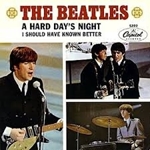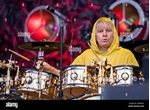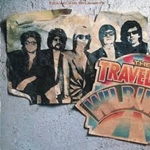- Register
- Log in to Tune-In
- Wishlist (0)
-
Shopping cart
(0)
You have no items in your shopping cart.
Beatles News

It’s 1964. The Beatles are the biggest band on Earth, Beatlemania is boiling over, and they’re about to make their movie debut. The soundtrack? An all-original album that opens with the most iconic chord in pop history. A Hard Day’s Night isn’t just a soundtrack—it’s a musical coming-of-age, a Lennon–McCartney songwriting masterclass, and a cultural time capsule all in one. But did you know these five behind-the-scenes nuggets? Prepare to “ooh!” and “yeah yeah yeah!”
1. The Opening Chord Has a Fan Club of Its Own (And a Math Professor Too)
The jarring, jangling, electrifying Fadd9 chord that opens “A Hard Day’s Night” has been analyzed by everyone from musicologists to mathematicians. George Harrison played it on a Rickenbacker 12-string, while George Martin added piano notes, Paul plucked a high bass note, and Ringo chimed in with subtle percussion.
One math professor even used Fourier transforms to break it down—basically turning rock history into rocket science. No chord has ever launched a film, an album, and a frenzy quite like this.
2. Ringo Starr Accidentally Named the Movie, the Album, and the Hit Singl details

The Beatles grew impressively as songwriters in the relatively short time that they recorded together. They generally stayed ahead of the curve when it came to using storytelling techniques that set their songs apart from their peers. One way that they were able to accomplish this was by occasionally springing a bit of a surprise on their listeners with a little twist to the story at the song’s end. Check out the following four examples of unexpected endings to songs by The Beatles to see what we mean.
“Drive My Car” from ‘Rubber Soul’ (1965)
The story goes that Paul McCartney brought an early version of this Rubber Soul opening track to John Lennon. Lennon rejected it on the basis that the lyrics, about diamond rings, sounded trite. Hence, McCartney went back to the drawing board. He came up with a story that works at face value if that’s the way you want to take it. A guy, needing some financial assistance, acts as a driver for a high-toned miss. Late in the song, however, he finds that the woman doesn’t quite have the assets that she promised him. You could also read this song as one giant metaphor about shifting power dynamics in a sexual relationship. In any case, the details

The Who has parted ways with its longtime drummer Zak Starkey. PEOPLE can confirm that he has split from the band
Starkey was with the band for 29 years. Zak Starkey is no longer with The Who.
PEOPLE can confirm that the drummer, 59, who is the son of The Beatles drummer Sir Ringo Starr and his first wife Maureen Starkey, has parted ways with the rock band after nearly 29 years.
"I’m very proud of my near 30 years with The Who," Starkey tells PEOPLE in a statement on Wednesday, April 16. "Filling the shoes of my Godfather, 'uncle Keith' has been the biggest honor and I remain their biggest fan. They’ve been like family to me."
He added: "In January, I suffered a serious medical emergency with blood clots in my right bass drum calf. This is now completely healed and does not affect my drumming or running."
"After playing those songs with the band for so many decades, I’m surprised and saddened anyone would have an issue with my performance that night, but what can you do?" Starkey added, appearing to reference a Metro report where Roger Daltrey had repeatedly said he was struggling to hear over the drums during The Who's Royal Albert Hall show last month. details

Music icon George Harrison said he was fine with Patti Boyd leaving him for Eric Clapton. It was the Cream guitarist who "had the problem."
The cracks between The Beatles' guitarist and his first wife had been forming for years. They had fallen in love on the set of the Fab Four's A Hard Day's Night, did everything together “as though they were a single entity," had bonded over spirituality throughout the late 1960s, and gotten through The Beatles highly public split.
However, eventually after receiving some love letters and other advances, Boyd couldn't help her attraction to Clapton anymore. Since she and Harrison had been growing apart for awhile, Harrison didn't think it was such a big deal that Boyd wanted to divorce him and begin a relationship with his close friend.
In a 1977 interview, Crawdaddy asked Harrison about his thoughts on Boyd being the inspiration of Clapton's hit song Layla while he was still married to her: "I remember him saying he was dedicating Layla to some mystery woman. Did you know what was happening?"
Source: themirror.com/Hannah Furnell

George Harrison might have had the moniker of the “Quiet Beatle,” but that doesn’t mean he didn’t speak up whenever he felt it was necessary, including turning rants into songs. Although Harrison’s songwriting contributions to the Beatles paled in comparison to John Lennon and Paul McCartney (much to Harrison’s chagrin), a handful of Harrison rants did make their way into the Fab Four catalogue.
Other emotional songs, many of which were directed at his former bandmates and business associates, came later in Harrison’s solo career, unhindered by commandeering co-workers.
“Taxman”
George Harrison might not have had as many songwriting credits to his Beatles legacy as John Lennon and Paul McCartney, but their 1966 album Revolver opened with one of his more fiery songs: “Taxman.” As Harrison recalled in Anthology, “I had discovered I was paying a huge amount of money to the taxman. You are so happy that you’ve finally started earning money. Then you find out about tax. In those days, we paid 19 shillings and sixpence out of every pound, and with supertax and surtax and tax-tax, it was ridiculous.”
Source: americansongwri details

“Anyone who is one of the best in his field, as [Bob] Dylan is, is bound to influence people,” John Lennon told Melody Maker in 1965. Lennon had revealed one of his biggest influences who helped shift his songwriting style and the Beatles’ sound. By 1964, Bob Dylan‘s influence on the Beatles was evident as they began transitioning from pop songs to more introspective songwriting. Traces of Dylan were drawn on Beatles for Sale and Help! and even earlier on the A Hard Day’s Night track “I Should Have Known Better,” which Lennon directly linked to Dylan.
Originally, “A Hard Day’s Night” was also more in the vein of Dylan before it became more of a Beatles pop song. “But later we Beatle-fied it before we recorded it,” Lennon added.
As the band continued pivoting on Rubber Soul, along with more experimentation with instrumentation and in their storytelling, which continued on through the more psychedelic tones of Revolver and Abbey Road, Dylan’s influence was still apparent.
“That’s me in my Dylan period again,” Lennon proudly said when discussing the band’s “I’m a Loser” from Be details

Traditional songwriting rules would dictate that the best compositions stay cohesive from start to finish, but Paul McCartney has been breaking that rule for decades, masterfully turning multiple songs into one in a way that still feels connected and exciting. His threading together of separate musical ideas was sometimes obvious, clearly delineating point A to B to C. Other times, McCartney created medleys so smooth that it’s easy to forget how many standalone ideas came together to form the track.
americansongwriter.coOf all the songwriting masterclasses McCartney has offered through his music, his ability to hodge-podge incredible rock and pop tracks together is impeccable. These are some of his best.
“Band on the Run”
One of the greatest examples of Paul McCartney mashing multiple songs into one track is “Band on the Run.” The 1973 title track to Wings’ third studio album features three distinct sections. It opens with a synth-heavy R&B groove, transitions into a more straightforward rock ‘n’ roll middle section, before finally ending with a jangly, country rock feel reminiscent of the Eagles.
The connecting thread between each section is the l details

The Traveling Wilburys weren’t supposed to exist. But when George Harrison needed a B-side in 1988, what began as a one-off jam between friends became one of the most delightful curveballs in rock history. Traveling Wilburys Vol. 1 arrived that October, sounding like it had been playing on your record player for decades—even if you had never heard it before. Let’s dig into five little-known facts about this Grammy-winning, triple-platinum classic that united Bob Dylan, Tom Petty, Roy Orbison, Jeff Lynne, and Harrison under one roof and five pseudonyms.
George Harrison didn’t plan a supergroup—he planned a barbecue. The magic started in Bob Dylan’s garage in Malibu. Harrison had rounded up Jeff Lynne and Roy Orbison to help him record a quick B-side. Needing a studio, he called Dylan. Needing his guitar, he swung by Tom Petty’s house and invited him, too. What was meant to be a throwaway track, “Handle with Care,” was so good that Warner Bros. refused to let it be buried. So they turned one song into ten, and a backyard hangout into rock and roll alchemy.
Source: Eric Alper/thatericalper.com

The Beatles had an immense impact on rock ‘n’ roll in a general sense, but some of the most signature sounds of the mid-20th century can be traced back to specific songs by the Fab Four—the 1970s, for example, have “And Your Bird Can Sing” to thank for one of the most popular guitar techniques of the era. Amid other album cuts like “Eleanor Rigby” and “Yellow Submarine,” it’s difficult to distinguish the Revolver B-side as one of the more well-known hits from the record.
Nevertheless, the rock world continued to hear elements of “And Your Bird Can Sing” for years after the Beatles finally called it quits. Even more interestingly, the rock subgenre that would use this Fab Four technique was one far removed from the Liverpool band: southern rock.
Source: Melanie Davis/american songwriter.com
details
Recently, rare recordings of The Beatles auditioning for Decca Records in 1962 surfaced in a Vancouver record shop. The store’s owner, Rob Frith, posted a demo clip to Instagram. And that clip proved that even in their earliest days, there was something special about The Beatles. And this was before Ringo Starr joined the band, as Pete Best was The Beatles’ drummer until August 1962.
Even when the Fab Four rolled through pop and R&B standards of the time, the collective of John Lennon, Paul McCartney, George Harrison, and eventually Ringo Starr was undeniable—even in its rawest form.
It’s amusing now to think about Decca rejecting The Beatles, but McCartney said in the Anthology autobiography, “We weren’t that good; though there were some quite interesting and original things.”
Here’s a look at three early Beatles songs that showcase what Decca missed.
“Money (That’s What I Want)” from ‘Anthology 1’ (1995)
“Your loving give me a thrill,
But your loving don’t pay my bills.”
Written by Motown founder Berry Gordy and songwriter Janie Bradford, The Beatles’ cover appeared as the details

One to One: John & Yoko showcases footage from the only full-length concerts Lennon performed after the Beatles — now stunningly restored in IMAX with a powerful remix by Sean Ono Lennon.
The documentary features unheard private phone calls that capture unfiltered moments of Lennon and Ono’s life, from politics to personal pain. The film reframes their U.S. move as a search for Ono’s kidnapped daughter, Kyoko — a heartbreaking story that shaped much of the period for them.
At a time when it seems like there’s little new left to say about any of the Fab Four, One to One: John & Yoko — which begins its IMAX run on April 11 — is both revelatory and daring.
Co-directed by Oscar winner Kevin Macdonald and Sam Rice-Edwards, the documentary explores perhaps the least celebrated period of John Lennon and Yoko Ono's life: their first 18 months as New Yorkers. Upon their arrival in August 1971, the pair found themselves in a country electrified by sociopolitical change — and they inadvertently became a lightning rod. Their shockingly accessible Greenwich Village home drew all manner of avant-garde artists, leftist activists, and self-proclaimed fre details

Paul McCartney and John Lennon wrote classic after classic for The Beatles but they weren't happy with all of them. John famously took aim at a number of Paul's songs after he left the band, sharing his disdain for 'Let It Be', 'Hello Goodbye', the 'Abbey Road' closing medley and 'Ob-La-Di, Ob-La-Da'.
Paul could also be critical of his own work and was happy to give songs away to other artists if he didn't think they were up to scratch. He gave his track 'A World Without Love' to Peter and Gordon because he didn't think it was good enough for The Beatles but it ended up topping the charts for the pop pair.
Ringo Starr also wasn't afraid to share which songs he wasn't a fan of. In a 2008 Rolling Stone interview, he said: "The worst session ever was 'Maxwell's Silver Hammer.' It was the worst track we ever had to record. It went on for f***ing weeks. I thought it was mad."
But one song that none of the band appeared to be keen on was 'If You've Got Trouble'. Written by John and Paul, the song was intended to be Ringo's vocal performance on the 'Help!' album, which accompanied their 1965 film of the same name.
The Beatles began recording it on February 18, 1965, which was the fourth day of their stu details

Following the culmination of the Beatles’ recording story with 1969’s Abbey Road, the former Fabs had carved out distinctive new solo identities. George Harrison set an early high bar with the exemplary double-album All Things Must Pass in 1970, while John Lennon had positioned himself firmly as a cultural figurehead of the revolutionary left. His utopian anthem Imagine became an enduring hymn for the ages.
Paul McCartney meanwhile, despite being quick off the mark to establish his solo career with 1970's amiable 'McCartney', had yet to garner consistent commercial success, or the same level of critical stock that his fellow Beatles were typically achieving.
Though his early solo offerings were creatively bountiful (1971’s gloriously quirky Ram in particular) and had achieved moderate success, it would take the formation of an entirely new band and a complete change of locale to finally land the song (and album) that would fulfil his solo ambitions. It was a song that channelled both his genius for melodicism with a structural fearlessness. An anthem that did much to cement McCartney as the enduring solo Beatle and one of rock's all-time greats.
This was McCartney's victorious gal details

Adam Levine is looking back on an awkward run-in with music royalty.
The Maroon 5 frontman said during a Thursday appearance on "The Howard Stern Show" that Beatles vocalist Paul McCartney once cracked a joke about Levine's performing skills, then over-corrected after fearing the quip had fallen flat.
"I told you I've been scared a handful of … times in my life, that was definitely one of them," Levine said of a performance he did alongside bandmates to honor 50 years of The Beatles. The televised tribute show, to mark 50 years since the British band had appeared on "The Ed Sullivan Show," saw Maroon 5 cover "All My Loving" − one of the group's signature hits. Footage of The Beatles themselves playing the iconic tune was projected behind them, Levine recalled, then paused to allow Maroon 5's performance halfway through to finish the rest of the song.
"I'm sorry man, you can be too cool, but not always," Levine recalled of performing in front of his heroes. "It's Ringo Starr and Paul McCartney.
Source: usatoday.com/
details
The Beatles’ breakup during the transition from 1969 to 1970 was a massive cultural shift for the entire world, but even that pales in comparison to the personal effects it had on each of the Fab Four’s lives. Paul McCartney, John Lennon, George Harrison, and Ringo Starr’s tenure as a commercial band might have been relatively short, but that seven-year stint was like an artistic lifetime.
For most of the members of the band, their next moves post-Beatles were a little more obvious. McCartney, Lennon, and Harrison were all individually talented songwriters, which made their career transition to solo artists or members of other bands a bit easier. But Starr was the drummer. His path forward wasn’t so clear-cut.
Ringo Starr Reflects On What It Was Like After Beatles Breakup
Depending on which conflict or walk-out you consider to be the final straw in the Beatles breakup, the band’s dissolution started between 1969 and 1970. Logistical issues like collecting contract signatures made the process even muddier. Regardless of the official date, the Fab Four were no more by 1971. Paul McCartney was writing his own music. John Lennon was busy with The Plastic Ono Band with his wife, Yok details
